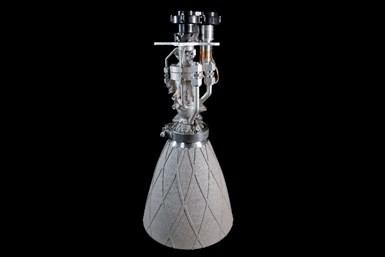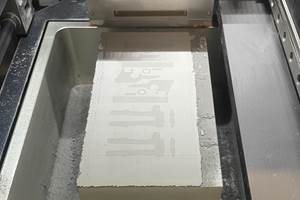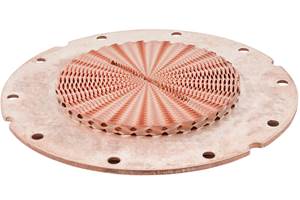6K Additive, Agile Space Industries Partner to Advance Moon Mission
6K Additive’s Nickel 625 powder is being qualified for use in Agile’s A2200 engine to leverage additive manufacturing for engine lightweighting while also delivering tremendous power.
Share
Read Next
6K Additive and Agile Space Industries are pursuing certification of 6K Additive-produced Ni625 powder for customer space applications including critical rocket parts. 6K Additive is a a division of 6K Inc. and a provider of sustainable materials for additive manufacturing (AM), while and Agile Space Industries is an in-space propulsion specialist.
6K Additive’s Ni625 powder is being certified for use at Agile’s manufacturing facility. The first parts to be produced will be used in Agile’s A2200 bipropellant hypergolic engine. The engine is powered by a pressure-fed hypergolic bipropellant, which does not require ignition as the hydrazine derivative fuel M20 and MON3 oxidizer combust on contact. Leveraging AM, the engine was designed to weigh just 5.9 kg and produce 500 lbs of thrust, underscoring the benefits of lightweighting with AM while delivering tremendous power.
“By weight, 85% of our engine components are additively manufactured, meaning we rely heavily on AM powders that can withstand the extreme temperatures and forces generated during takeoff and flight. 6K Additive allows us to additively manufacture using high-quality powders that are required for our critical applications, while also helping us meet our environmental goals through their recycling program and sustainably manufactured powders,” says Kyle Metsger, director of additive technology at Agile. “6K Additive can deliver extremely consistent powder that allows our production line to run the long build times required for these complex components.”
Traditional development cycles for aerospace components can be more than two decades. However, by harnessing the speed and flexibility of AM, Agile is able to compress development time down to 12 months. “A year-long development cycle still sounds like a very long time in many industries, but we are showing the primes in the aerospace industry what the future looks like,” Metsger adds. “Moving to the larger TruPrint 5000 machine gave us the ability to qualify the new parameters for the machine and material simultaneously. In this way, AM allows us to be ‘Agile’ in name and practice.”
Agile’s A2200 engines will be used on a Lunar lander vehicle. The A2200 engine was developed to provide maximum performance on demanding missions, with a specific impulse of more than 318 seconds. Using an integral pintle sleeve throttling mechanism, the engine is capable of deep throttling, providing a smooth ride and fine control for a variety of missions. The engine can throttle from 50 to 100% thrust in under 650 milliseconds, making it the perfect engine for heavily demanding maneuvering sequences that lunar missions require.
“We are always excited to partner with customers like Agile who leverage our high-quality powders to produce critical rocket parts to land on the moon,” says Frank Roberts, 6K Additive president. “The fact that we can enable space exploration while continuing to lead the way with sustainability at home on Earth is the best of both worlds. Agile has a cradle-to-grave mentality around its products, and having 6K Additive supply the company with high-quality, sustainably produced Ni625 and provide an established waste stream to help with its environmental stewardship speaks to our mission of going beyond expectations for our customers.”
- Learn about Morf3D and 6K Additive qualifying metal powders for aerospace customers. 6K Additive’s sustainably produced powders will be qualified for full industrialization and high-volume production.
- Read about 6K’s efforts to make the U.S. self-sufficient in aerospace alloy metal powders. 6K’s technology can upcycle titanium and nickel-alloy parts into additive manufacturing powder. Here is how the circular economy helps national security.
Related Content
AM 101: What Is Binder Jetting? (Includes Video)
Binder jetting requires no support structures, is accurate and repeatable, and is said to eliminate dimensional distortion problems common in some high-heat 3D technologies. Here is a look at how binder jetting works and its benefits for additive manufacturing.
Read MoreWith Electrochemical Additive Manufacturing (ECAM), Cooling Technology Is Advancing by Degrees
San Diego-based Fabric8Labs is applying electroplating chemistries and DLP-style machines to 3D print cold plates for the semiconductor industry in pure copper. These complex geometries combined with the rise of liquid cooling systems promise significant improvements for thermal management.
Read MoreAdditive Manufacturing Is Subtractive, Too: How CNC Machining Integrates With AM (Includes Video)
For Keselowski Advanced Manufacturing, succeeding with laser powder bed fusion as a production process means developing a machine shop that is responsive to, and moves at the pacing of, metal 3D printing.
Read MoreVulcanForms Is Forging a New Model for Large-Scale Production (and It's More Than 3D Printing)
The MIT spinout leverages proprietary high-power laser powder bed fusion alongside machining in the context of digitized, cost-effective and “maniacally focused” production.
Read MoreRead Next
Postprocessing Steps and Costs for Metal 3D Printing
When your metal part is done 3D printing, you just pull it out of the machine and start using it, right? Not exactly.
Read MoreProfilometry-Based Indentation Plastometry (PIP) as an Alternative to Standard Tensile Testing
UK-based Plastometrex offers a benchtop testing device utilizing PIP to quickly and easily analyze the yield strength, tensile strength and uniform elongation of samples and even printed parts. The solution is particularly useful for additive manufacturing.
Read MoreBike Manufacturer Uses Additive Manufacturing to Create Lighter, More Complex, Customized Parts
Titanium bike frame manufacturer Hanglun Technology mixes precision casting with 3D printing to create bikes that offer increased speed and reduced turbulence during long-distance rides, offering a smoother, faster and more efficient cycling experience.
Read More





















